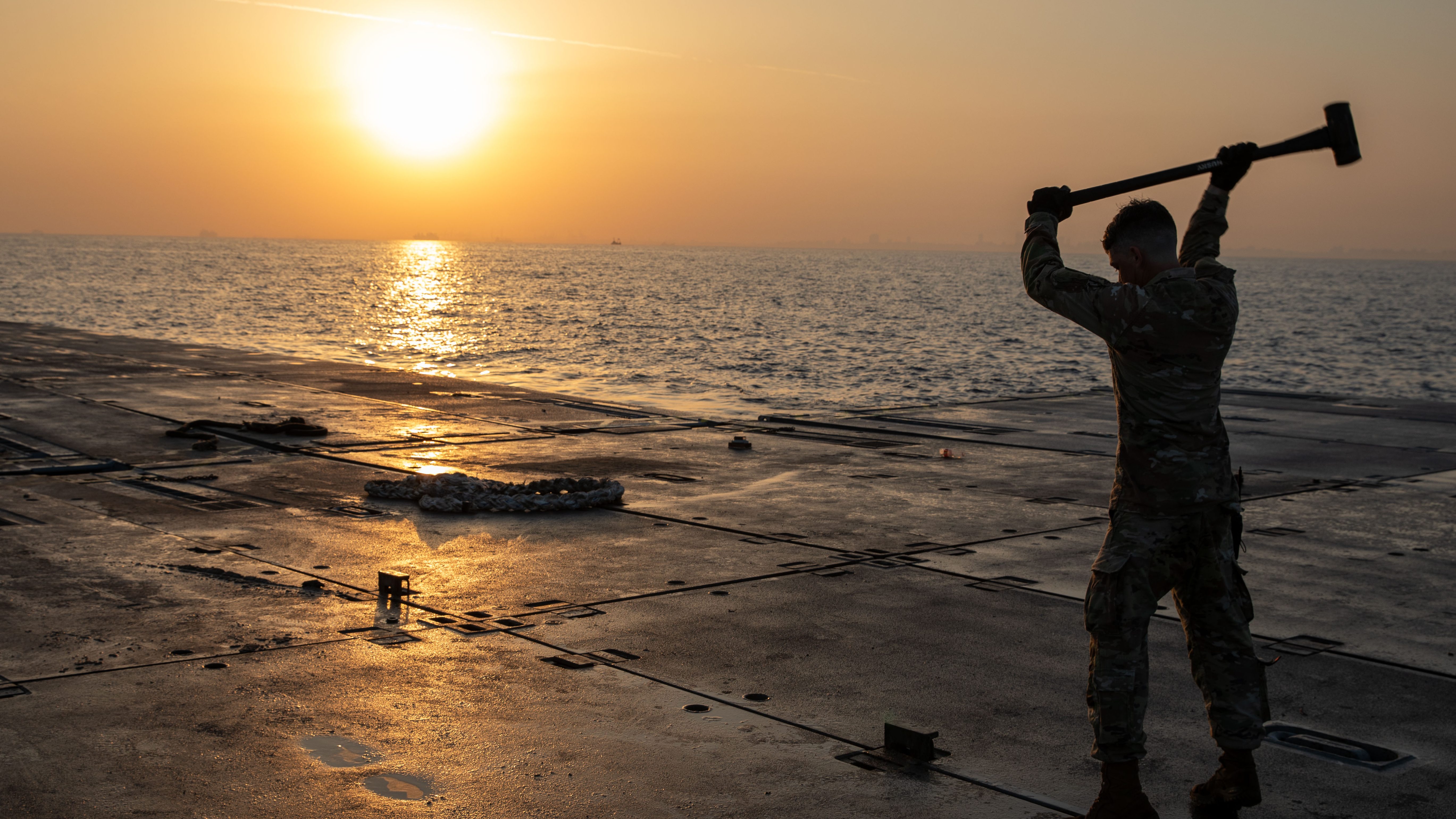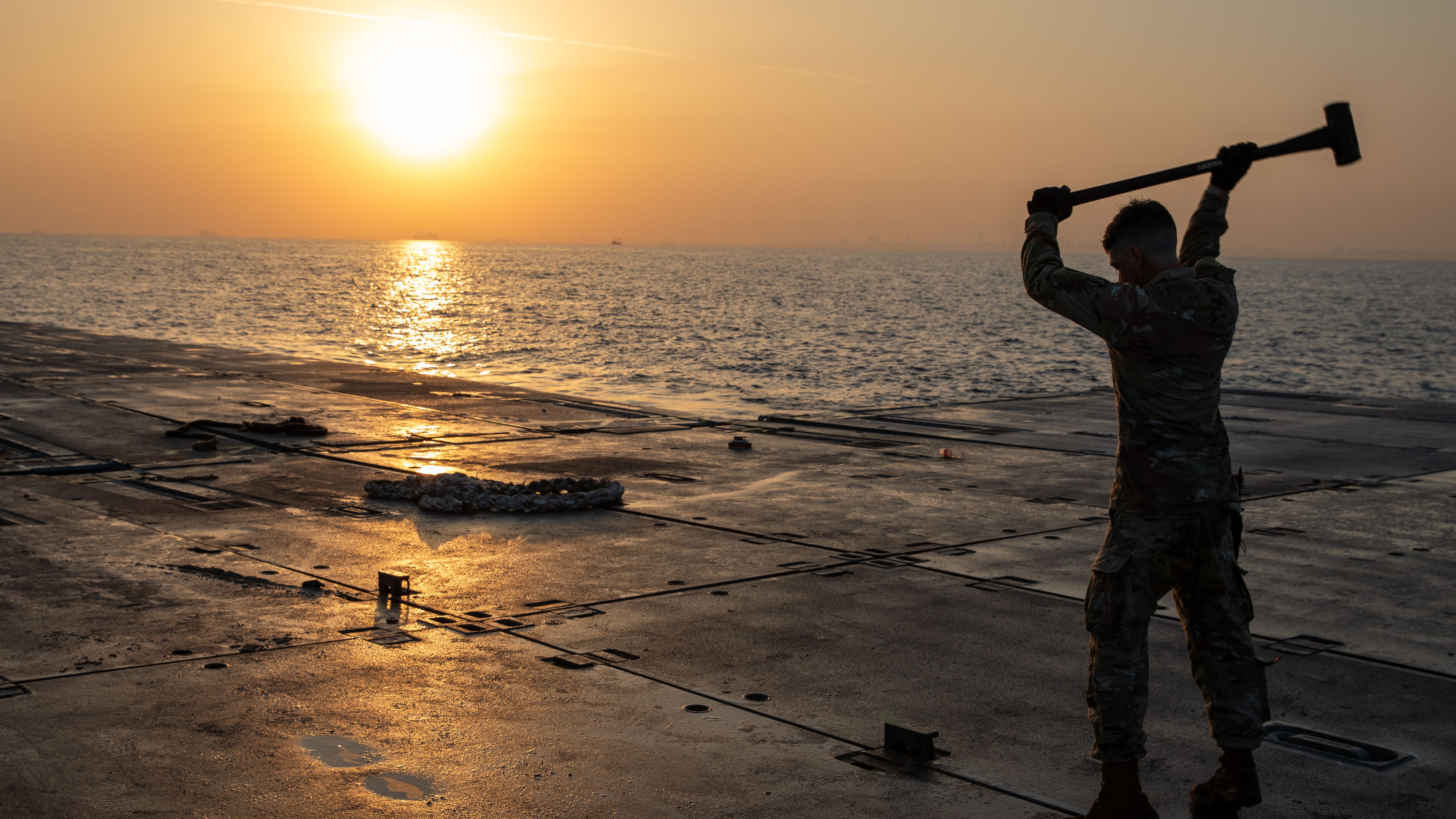

The U.S. military’s use of a post-World War II era floating pier system to deliver humanitarian assistance into Gaza has come to an end. The operation launched with high hopes of delivering aid by sea but numerous logistics setbacks and criticism of the effort as, at best, a band aid for the depravations in Gaza and, at worst, a dodge for applying diplomatic pressure to force Israel to open more land crossings.
The U.S. military’s mission involving the pier is officially finished but U.S. assets are still helping with aid coordination in Israel, officials said Wednesday.
“The maritime service mission involving the pier is complete. There’s no more need to use the pier, particularly because we’re able to implement a more sustaining pathway through Ashdod,” said Vice Adm. Brad Cooper, deputy commander of U.S. Central Command.
The same U.S. Army vessels that transported humanitarian aid from Cyprus to the U.S. military’s pier off the coast of Gaza will now bring the aid from Cyprus to a port in Ashdod, Israel – a city just over 20 miles south of Tel Aviv. After reaching Ashdod, aid will be transported by truck to northern access gates in Gaza, officials said. Officials did not give specifics on the operational changes for the Army watercraft vessels but said the ships will still be involved in aid delivery.
Officials also said Wednesday that a soldier severely injured during the pier’s mission was still being treated in a San Antonio, Texas hospital and is “no longer in critical condition.” They did not offer more details.
The pier was envisioned as a humanitarian lifeline for Palestinians in Gaza facing chronic starvation and a lack of consistent aid delivery due to land route limitations by the Israeli military. During humanitarian deliveries, aid groups have been terrorized by attacks from Hamas and the Israeli military.
As the pier operation faced skepticism, U.S. officials doubled down on their support of the project’s transition to an Israeli port. Cooper said the U.S. military already helped to deliver more than a million pounds of aid through Ashdod.
“We’re very confident in the sustaining element of this moving forward,” he added.
President Joe Biden announced plans for the temporary pier, which the military calls a Joint Logistics Over The Shore, or JLOTS system, during his March State of the Union speech. The pier was officially set up in mid-May and was operational for “a little more than 20 days,” officials said.
U.S. military assets delivered 19.4 million pounds of aid over the pier since it opened, which Cooped called the “highest volume of humanitarian assistance that the U.S. military has ever delivered to the Middle East.” The deputy commander also called JLOTS a “historically unprecedented operation to deliver aid into an active combat zone without any U.S. boots on the ground or any preexisting supporting infrastructure.”
Subscribe to Task & Purpose today. Get the latest military news and culture in your inbox daily.
The cost of the pier project was less than what officials budgeted for, Cooper said. In total, the roughly 20 million pounds of aid delivery cost just under $230 million which he compared to the JLOTS mission in Haiti which cost $460 million for 23 million pounds of aid.
In May, JLOTS suffered its first blow when the temporary pier was damaged by rough sea states, temporarily suspending the delivery of humanitarian aid and briefly stranding U.S. boat crews aboard tender vessels run aground. By June, the pier had been shut down three separate times.
“In my experience, the reason why it’s so sensitive is, number one, the equipment is old,” Former Navy utility boat coxswain Jarod Palm told Task & Purpose. “Number two, it’s all ‘Lego bricked’ together, and that platform is actually held together by line.”
Despite its issues, Cooper said the Department of Defense’s assessment is that the pier “achieved its intended effect to surge a very high volume of aid into Gaza, and ensure that aid reaches the civilians in Gaza in a quick manner.”
The temporary pier project also came under fire from humanitarian advocates who called for increased diplomatic pressure on Israel to open more land crossings which U.S. officials acknowledged as “the most effective and efficient way” to deliver aid into the Gaza strip.
Aid delivery by land route still exists through Kerem Shalom, Gate 96, the Jordan corridor, and Ashdod. U.S. officials said there were no updates on the decision to reopen the Rafah border crossing between Israel and Egypt.
“We are unfortunately in a situation where the insecurity has increased again and we’re seeing a rise in looting and other kinds of criminal activities and that is definitely causing problems for aid distribution right now,” said Sonali Korde, Assistant to the USAID’s Administrator’s Bureau for Humanitarian Assistance. “Every day the situation is different on the ground but we continue to look ahead with our partners at the distribution issues.”
The temporary pier is a capability that the services, particularly the Army, have deployed for previous humanitarian missions like the 2010 Haiti earthquake and for multinational training exercises. The Army even used JLOTS in the Pacific region as part of training operations to prepare for a potential war with China.
